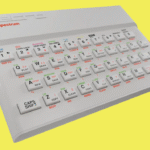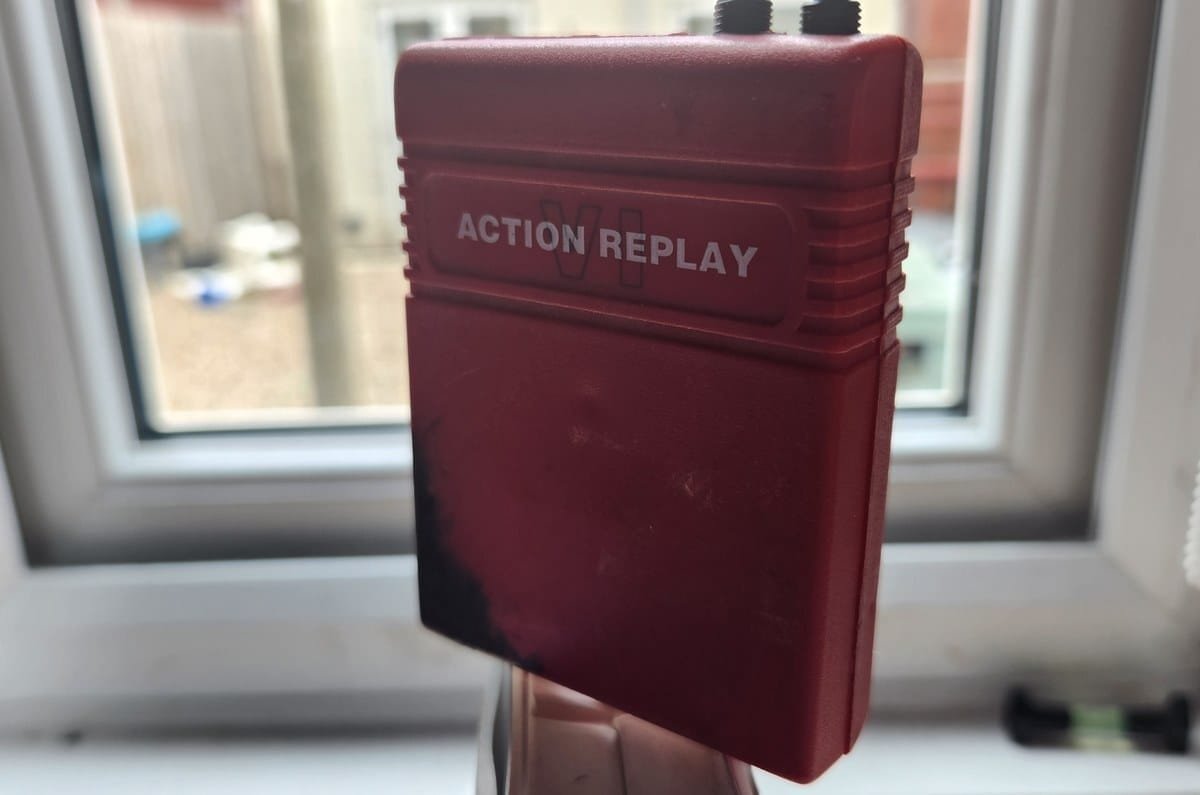This Commodore 64 cartridge changed how I used computers, and redefined my understanding of what was possible.
I don’t know when I first saw the advert for the Acton Replay cartridge. It would have been in Zzap64!, or Commodore User, and after I became aware of carts like the Freeze Frame backup cart. At this time, games weren’t available on cartridge in the UK, unless you had a copy of International Soccer, although a few applications shipped with RAM expansions.
My main reason for wanting the Action Replay from Datel Electronics was, I’m sorry to say, piracy. Mostly, I wanted to make copies of my own games, speed up loading (the cartridge added a turbo loader tool for tapes and disk) and get infinite lives in some games.
(Of course, that’s a dangerous thing to do in certain titles – the infinite death loop in Jet Set Willy, for example!)

Sprite Control
At first, I was happy with the main features. But then, I discovered Sprite control. Thanks to a cassette demo of Robocop 2 (which eventually launched on cartridge only), I was able to lift the main sprite out of the game and drop it into Turrican.
(Cartridges for the C64 were rare in the UK for most of the 1980s, and it wasn’t until the arrival of the C64 GS that they took off – if you can call it that. C64 cartridges are still released, however.)
Suddenly, games stopped being these monolithic works of genius, constructed by superior intelligences. All those hours of pouring over code I didn’t understand, with no concrete context, and poor explanations might have been wasted, but this changed things.
I’d just discovered the rudimentary basics of a modern game, the sprite editor, and it wasn’t long before I found a copy of Shoot Em Up Construction Kit. But that’s another story.
My Action Replay VI
As my C64 has not been powered up in 20 years, I’m reluctant to risk it without a new PSU. So, does my cart work or not? I’m not sure, but I do know that it survived the blue ink splash you can see in the lower corner.

I think I’ve kept the box contents reasonably intact. As you can see, I still have the guide, which interestingly features a duplicate sheet of pages 6, 7, 18, and 19. This is possibly some form of addendum.

The eagle-eyed among you will notice a slot for a cassette, a 3.5-inch disk, and a 5.25-inch disk. I genuinely cannot remember whether the cassette or the disk shipped with this Action Replay, and I have no idea where it is at this time. My C64 disk collection is relatively modest, and it isn’t with those.
A mystery to be solved later!
Did it change my life?
I bought the Action Replay VI with my own money, paying (I suspect) with a postal order. Suddenly having the power of backups, I felt like it was the missing part of my C64, but to be honest, it wasn’t that long before we moved onto the Amiga.

Having said that, it’s another lovely big box product, with a useful, printed guide. It certainly made life easier, bringing an end to those mind-numbing cassette loading times, and perhaps colouring my C64 memories in a positive light.
But back then, there were just some games that you couldn’t copy, or add infinite lives to.
Replay the action
As you may know, the Action Replay carts transcended the 8-bit era. Later becoming a cheat device, the Action Replay was released on Nintendo DS, Nintendo DSi, Nintendo 3DS, PlayStation Portable, PlayStation 2, GameCube, Game Boy Advance, and the Xbox.
There was even a Windows 95/98 version!
Datel still exists, its website still active, and seems to still supply Wii and DS hardware. But really, in the age of instant digital downloads, it seems strange they’re not leaning into the retro revival a bit…
Affiliate Disclosure: Some of the links in this post may be affiliate links, which means I may earn a small commission if you make a purchase through those links. This comes at no extra cost to you. Thank you for your support!
Christian Cawley is the founder and editor of GamingRetro.co.uk, a website dedicated to classic and retro gaming. With over 20 years of experience writing for technology and gaming publications, he brings considerable expertise and a lifelong passion for interactive entertainment, particularly games from the 8-bit and 16-bit eras.
Christian has written for leading outlets including TechRadar, Computer Weekly, Linux Format, and MakeUseOf, where he also served as Deputy Editor.
When he’s not exploring vintage consoles or retro PCs, Christian enjoys building with LEGO, playing cigar box guitar, and experimenting in the kitchen.









